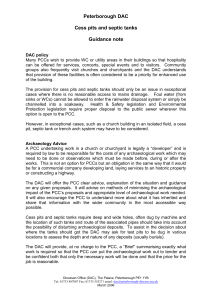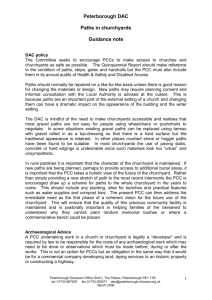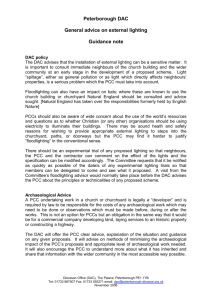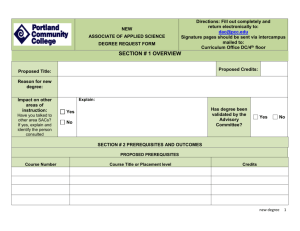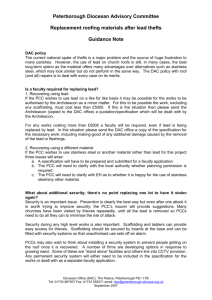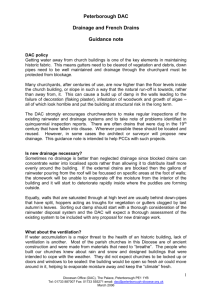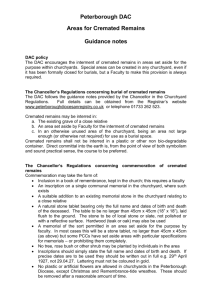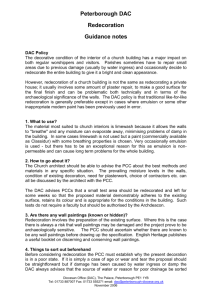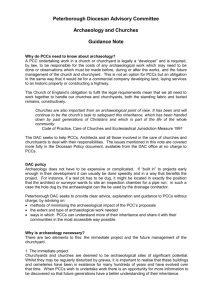Churchyard walls - Peterborough Diocesan Registry
advertisement
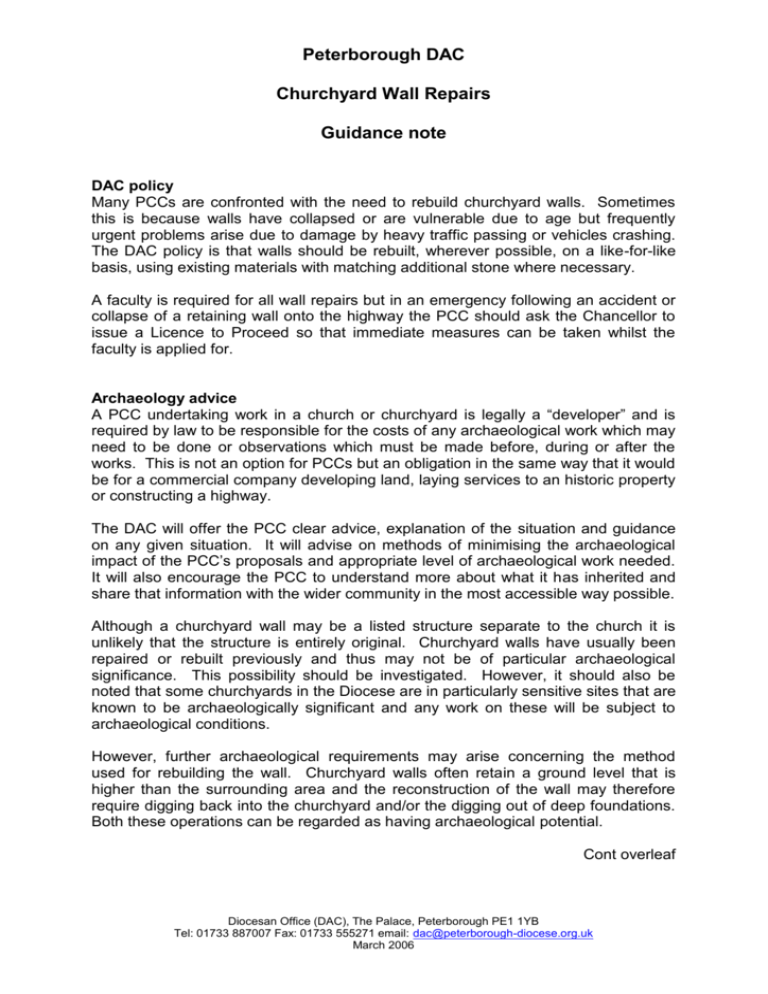
Peterborough DAC Churchyard Wall Repairs Guidance note DAC policy Many PCCs are confronted with the need to rebuild churchyard walls. Sometimes this is because walls have collapsed or are vulnerable due to age but frequently urgent problems arise due to damage by heavy traffic passing or vehicles crashing. The DAC policy is that walls should be rebuilt, wherever possible, on a like-for-like basis, using existing materials with matching additional stone where necessary. A faculty is required for all wall repairs but in an emergency following an accident or collapse of a retaining wall onto the highway the PCC should ask the Chancellor to issue a Licence to Proceed so that immediate measures can be taken whilst the faculty is applied for. Archaeology advice A PCC undertaking work in a church or churchyard is legally a “developer” and is required by law to be responsible for the costs of any archaeological work which may need to be done or observations which must be made before, during or after the works. This is not an option for PCCs but an obligation in the same way that it would be for a commercial company developing land, laying services to an historic property or constructing a highway. The DAC will offer the PCC clear advice, explanation of the situation and guidance on any given situation. It will advise on methods of minimising the archaeological impact of the PCC’s proposals and appropriate level of archaeological work needed. It will also encourage the PCC to understand more about what it has inherited and share that information with the wider community in the most accessible way possible. Although a churchyard wall may be a listed structure separate to the church it is unlikely that the structure is entirely original. Churchyard walls have usually been repaired or rebuilt previously and thus may not be of particular archaeological significance. This possibility should be investigated. However, it should also be noted that some churchyards in the Diocese are in particularly sensitive sites that are known to be archaeologically significant and any work on these will be subject to archaeological conditions. However, further archaeological requirements may arise concerning the method used for rebuilding the wall. Churchyard walls often retain a ground level that is higher than the surrounding area and the reconstruction of the wall may therefore require digging back into the churchyard and/or the digging out of deep foundations. Both these operations can be regarded as having archaeological potential. Cont overleaf Diocesan Office (DAC), The Palace, Peterborough PE1 1YB Tel: 01733 887007 Fax: 01733 555271 email: dac@peterborough-diocese.org.uk March 2006 In such cases the DAC will advise that there should be archaeological monitoring and possibly a programme of archaeological test-pitting to assess the depth and nature of the deposits behind the wall (usually burials). The DAC will provide, at no charge to the PCC, a “Brief” summarising exactly what work is required so that the PCC can put the archaeological work out to tender and be confident both that only the necessary work will be done and that the price for the job is reasonable. Information that will be required for a Faculty application A plan of the churchyard preferably to scale, showing the extent and location of the proposed work A description of the wall e.g. size, composition, current status, whether retaining or not, if adjacent to a highway or public footpath and condition Photographs illustrating the situation (snapshots are enormously helpful) Details of the methods to be used: mortar mix, any new stones, type of coping, whether wall to be dismantled and rebuilt on existing foundations or reconstructed entirely using different techniques e.g. additional drainage holes, strengthening bars etc. Information about the amount of sub-soil or soil behind a retaining wall to be removed to allow the work to be done Details of whether the church architect has been involved in the project Specification and/or estimate for the work Wider consultation It is possible that the Local Authority, English Heritage or other bodies will need to be consulted about proposals. If the DAC believes that this is the case the PCC will be advised early on in the consideration of the work. The DAC will do its best to help the PCC to achieve good communication with whatever bodies have to be involved. The consultation may only require correspondence but in some cases a site meeting will need to be convened. Occasionally the DAC will not advise consultation at the outset but the Chancellor will require it when the faculty application is made, however such cases are very rare. If the wall is listed separately from the church the local authority must be consulted. Churchyard walls are often archaeologically significant. The PCC may need to fund archaeological evaluation or recording (see above). If the church architect or surveyor has not drawn up the specification the DAC is likely to suggest that s/he should be consulted. There may be technical aspects of the project as well as the issue of the work’s impact on the church that should be discussed with the architect or surveyor. The PCC may find it helpful to do this at the outset rather than after the DAC has discussed the proposals. In some instances a structural engineer’s advice should be sought. If the DAC considers that this is the case the PCC will be advised accordingly. Diocesan Office (DAC), The Palace, Peterborough PE1 1YB Tel: 01733 887007 Fax: 01733 555271 email: dac@peterborough-diocese.org.uk March 2006
